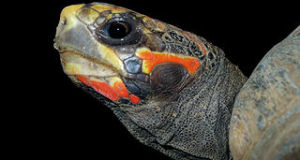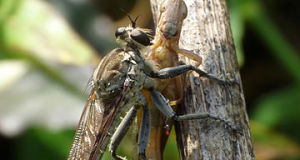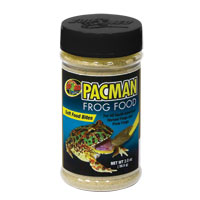Note: Please see my article Product Review: Gel Based Water Sources for House Crickets for additional information on cricket-keeping.

According to studies carried out at the Bronx Zoo, house crickets, Acheta domestica, should be allowed to feed for at least 48 hours before themselves being offered to captive reptiles and amphibians as a dietary item. This time period allows the crickets to absorb nutrients that will, ideally, offset their naturally poor ratio of calcium to phosphorus (which should, in most situations, be 2:1).
Feeding Crickets
Chick laying mash, trout chow and baby cereal can all be fed to crickets, but none are formulated specifically for these insects, and each has disadvantages. When feeding crickets in public collections or at home, I now rely exclusively upon commercial cricket foods. The following products are all very well-accepted by these perpetually hungry little beasts, and the nutritional profiles of the diets (including calcium content) are based on the latest available research:
Ziegler Monster High Calcium Cricket Food
R-Zilla Gutload Cricket Supplement
Dietary Supplements
 As has always been my practice, I add a bit of Tetra-Min Flake Fish Food to the commercial cricket foods. Both are consumed ravenously, and the wide variety of ingredients in the flakes helps assure that the crickets are receiving a healthful diet.
As has always been my practice, I add a bit of Tetra-Min Flake Fish Food to the commercial cricket foods. Both are consumed ravenously, and the wide variety of ingredients in the flakes helps assure that the crickets are receiving a healthful diet.
In addition, I add to their diets the powdery residue left at the bottom of oatmeal, wheat germ, nut and whole grain cereal containers. Oranges, yams, kale, carrots and other fruits and vegetables should also be provided on occasion, but only in amounts that are consumed quickly, lest mold develop.
 That Reptile Blog – Reptile, Amphibian and Exotic Pet Care and Information
That Reptile Blog – Reptile, Amphibian and Exotic Pet Care and Information




Hi, I’m determined to feed my crickets properly, but just wondering can we really know that much specific info about what they need and how to prepare them for feeding to reptiles or amphibians. ?I’m asking because I have read so amny different opinions in books and on the internet, 1 small paperback written 10 or more years ago suggested a highly varied diet for crickets…I was able to get very valuable information about reptile pets from other books that this author wrote and so I thought his ideas on feeding crickets would be correct also. Thank you!
Hello, Frank Indiviglio here. Thanks for your interest in our blog.
Much of what we know about the nutritional needs of insects is based on research undertaken to determine the proper way to feed and maintain laboratory insects – roaches, fruit flies, mealworms etc. Fortunately for herp enthusiasts, house crickets are useful laboratory animals in addition to being tasty pet food. The cricket foods mentioned in my article are formulated according to the nutritional guidelines established for laboratory cricket colonies. Crickets have figured prominently in much important research, so it was in the interests of science (not pet-keeping!) that the diets were originally devised. But the important point is that we can, I believe, rest assured that the information is sound.
Its often useful to search lab journals when researching pet needs…back when snake breeding was first coming into its own, many were surprised to find that much useful information on the topic – temperature and day length cycling for instance, had been published decades earlier in various lab reports and journals. The researchers were not interested in snakes per se, but needed snakes eggs for their work, and so learned how to get them!
The information concerning the calcium: phosphorus ratio is based on general vertebrate biology, but has proven useful when applied to reptiles and amphibians. The “48 hour” recommendation is the result of research carried out by the Bronx Zoo’s nutrition department in the late 1980’s. It is useful, as in large groups many crickets may not get to feed right away, but I do not believe it is ironclad. Certainly it is better to let your crickets feed for any amount of time, however short, before using them as food for your pets.
I believe the book you are referring to is “The Proper Way to Feed Insect-Eating Lizards” and you are quite right – author Philippe de Vosjoli is top notch, and broke new ground in many areas. You will never go wrong following his advice. The line of books to which you refer, originally published by Advanced Vivarium Systems, were and remain among the best available.
The lizard book was published before the advent of widely-available cricket diets (with 1 exception, I believe). However, much of the information therein is still valid…unfortunately, many do not take the time to provide the varied diet that Mr. de Vosjoli recommends. As you may have noticed in my article, I favor adding some variety to your cricket’s commercial diet as a “safety net” (fish flakes, oatmeal, cereals, fruit, vegetables, etc.).
Thanks for raising these questions… I think they will be very useful to other readers, and I appreciate the opportunity to look further into these important issues.
Best regards, Frank Indiviglio.
hi i thenk thes stuf is cool
Hello, Frank Indiviglio here.
Thanks for your feedback…I look forward to your future questions and comments.
Best regards, Frank Indiviglio